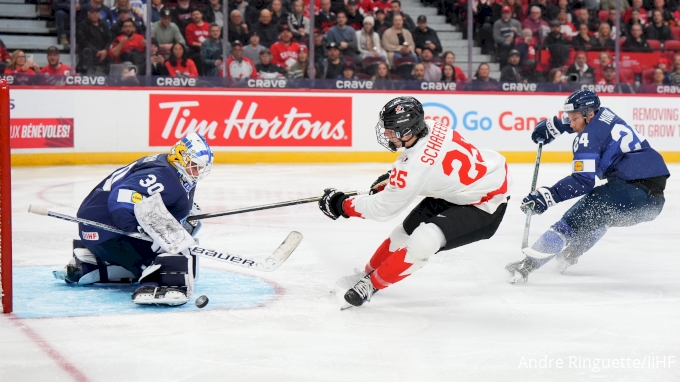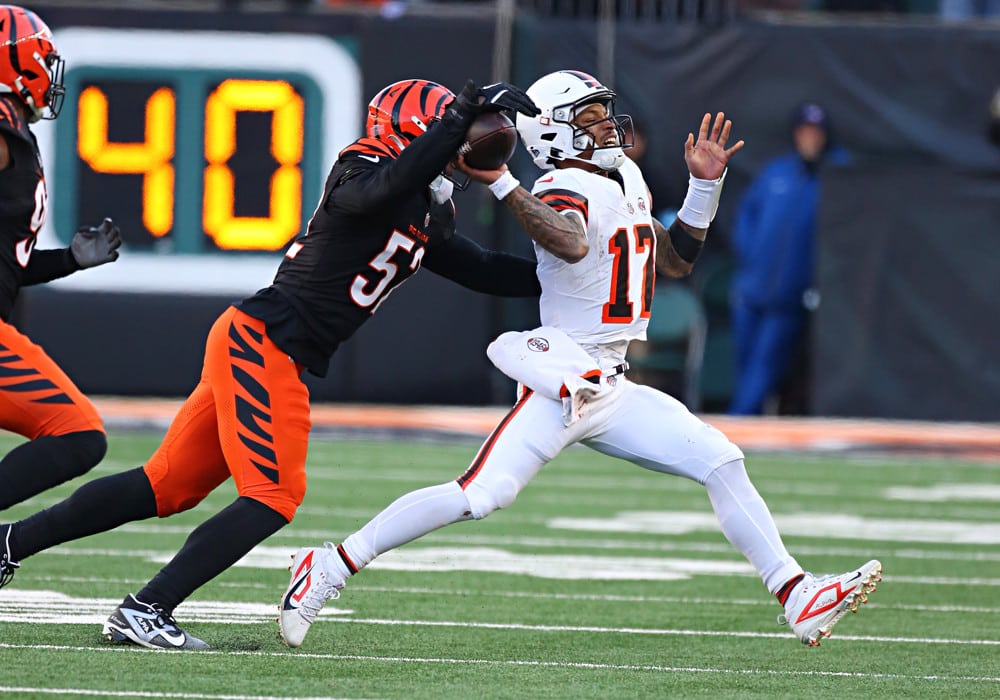Gambling
2024 Presidents Cup Preview
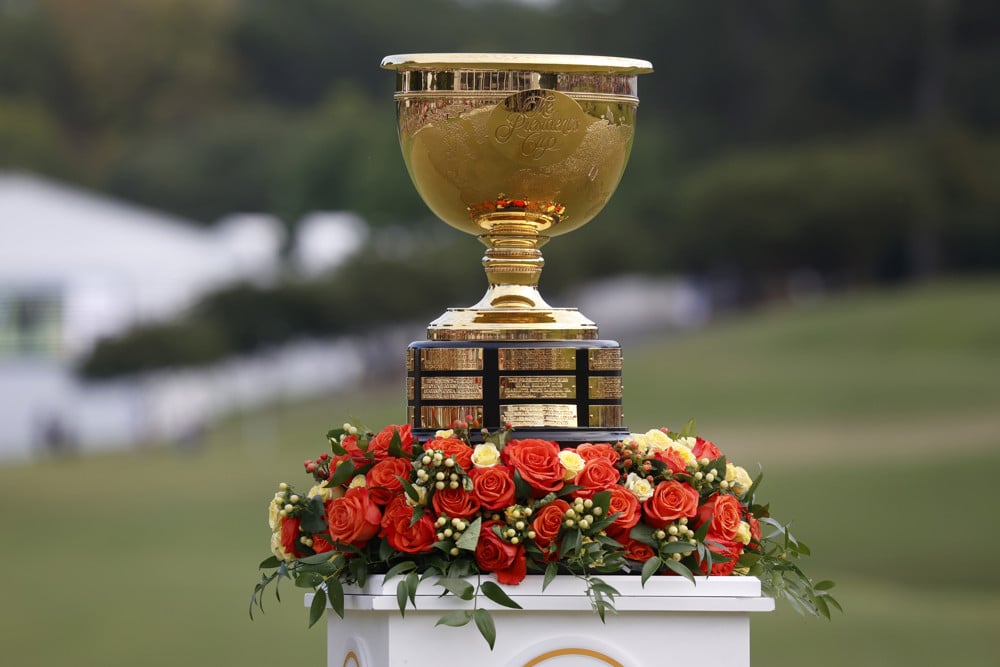
Late September means it’s time to fire up the patriotism in golf. This week marks the 16th playing of the Presidents Cup at the Royal Montreal Golf Club in Montreal. As always, here is your early preview of the 2024 Presidents Cup and both strategies and trends to consider before betting the event.
Go here for more Golf content!
| Ranking | Sportsbook and Casino App | Rating | Welcome Offer | Promo Code | Terms & Conditions |
|---|---|---|---|---|---|
| SGPN’s Top Book | Caesars | 4.9 | $1,000 Back in Bonus Bets if Your First Bet Doesn’t Win! | No Code Needed | Must be 21 or older and physically present in AZ, CO, IL, IN, IA, KS, KY, LA, ME, MD, MA, MI, NJ, NY, NC, OH, PA, TN, VA, WV, or WY. New users only. Must register using eligible promo code. First bet after registration must qualify. Max. Bonus Bet: $1,000. Bonus Bet expires 14 days after receipt.Void where prohibited. See Caesars.com/promos for full terms. Gambling Problem? CO, IL, KY, MD, MI, NJ, OH, TN, VA, WV, WY,KS (Affiliated with Kansas Crossing Casino), LA (Licensed through Horseshoe Bossier City and Harrah’s New Orleans),ME (Licensed through the Mi’kmaq Nation, Penobscot Nation, and Houlton Band of Maliseet Indians, federally recognized tribes located in the State of Maine),NC (Licensed through Tribal Casino Gaming Enterprise), PA (Affiliated with Harrah’s Philadelphia):If you or someone you know has a gambling problem, crisis counseling and referral services can be accessed by calling 1-800-GAMBLER (1-800-426-2537) or MD: visitmdgamblinghelp.org or WV: visit 1800gambler.net; AZ: Call 1-800-NEXTSTEP; IN: Call 1-800-9-WITH-IT; IA: Call 1-800- BETSOFF.©2024, Caesars Entertainment Gambling Problem? Call 1-800-GAMBLER MA:CALL 1-800-327-5050 or visitgamblinghelplinema.org NY: Call 877-8-HOPENY or text HOPENY (467369) |
| 2 | BetMGM | 4.8 | Get up to $1500 Paid Back in Bonus Bets | No Code Needed | Gambling problem? Call 1-800-GAMBLER (Available in the US) Call 877-8-HOPENY or text HOPENY (467369) (NY) Call 1-800-327-5050 (MA) 21+ only. Please Gamble Responsibly. Call 1-800-NEXT-STEP (AZ), 1-800-BETS-OFF (IA), 1-800-981-0023 (PR). First Bet Offer for new customers only (if applicable). Subject to eligibility requirements. Rewards are non-withdrawable bonus bets that expire in 7 days. In partnership with Kansas Crossing Casino and Hotel. See BetMGM.com for Terms. US promotional offers not available in DC, Mississippi, New York, Nevada, Ontario, or Puerto Rico. |
| 3 | Underdog Fantasy | 4.9 | Double Your First Deposit Bonus Up To $1000 | No Code Needed | Must be 21+. Gambling Problem? Call 1-800-GAMBLER. |
2024 Presidents Cup Preview
The Golf Course
Royal Montreal Golf Club is the oldest golf club in North America. It was founded by an eight men committee in 1873 with permission from Queen Victoria to use the prefix “Royal” in 1884.
Since its founding in 1873, the club has moved twice. Its current home sits on Ile-Bizard, an island outside downtown Montreal. It was there that Dick Wilson, the golf architect responsible for Bay Hill Golf Club and Doral, built a 45 hole layout. Of these 45 holes is the Blue Course, which will be used for the 2024 Presidents Cup.
Later in 2004, Rees Jones renovated the Blue Course so that it could host modern men’s professional tournaments. After his work, Royal Montreal hosted the 2007 Presidents Cup (won by the United States 19-15) and the Canadian Open in 2014 (won by Tim Clark).
For those who are avid fans and watchers of the RBC Canadian Open, the Blue Course at Royal Montreal looks pretty similar to other golf courses featured at that event:
The Blue Course has a classic parklands layout with narrow fairways, thick bluegrass rough and small bentgrass/poa annua greens flanked by greenside bunkers and more thick bluegrass rough. And it also looks remarkably similar to other Rees Jones designs, particularly with its routing and both the shape and placement of bunkers.
For example:
1st Hole – Royal Montreal

1st Hole – Torrey Pines South

While many Rees Jones golf courses can be absolute brutes, one of his main criticisms is his lack of creativity, imagination, or variance in his designs. Most of his creates feature slight doglegged holes with narrow fairways, a landing zone off the tee guarded by a puzzle shaped fairway bunker, and small greens guarded both left and right by more puzzle shaped bunkers. And both the first at Royal Montreal and Torrey Pines South feature exactly that.
And unfortunately for the next 13 holes, it’s more of the same. Over and over, players play slight doglegged holes with puzzle shaped fairway bunkers placed between 280-310 yards from the tee, with small greens flanked both left and right with similar puzzle shaped bunkers. Over. And over. And without much elevation change on the property, viewers might have a difficult time seeing a hole and knowing exactly which one it is. Because, to be frank, most of the first 13 holes look and play exactly the same.
But what might make Royal Montreal Golf Club a pretty good match play golf course (despite some rather bland design philosophies), is the final five holes. It’s there where matches can flip in a hurry thanks to water.
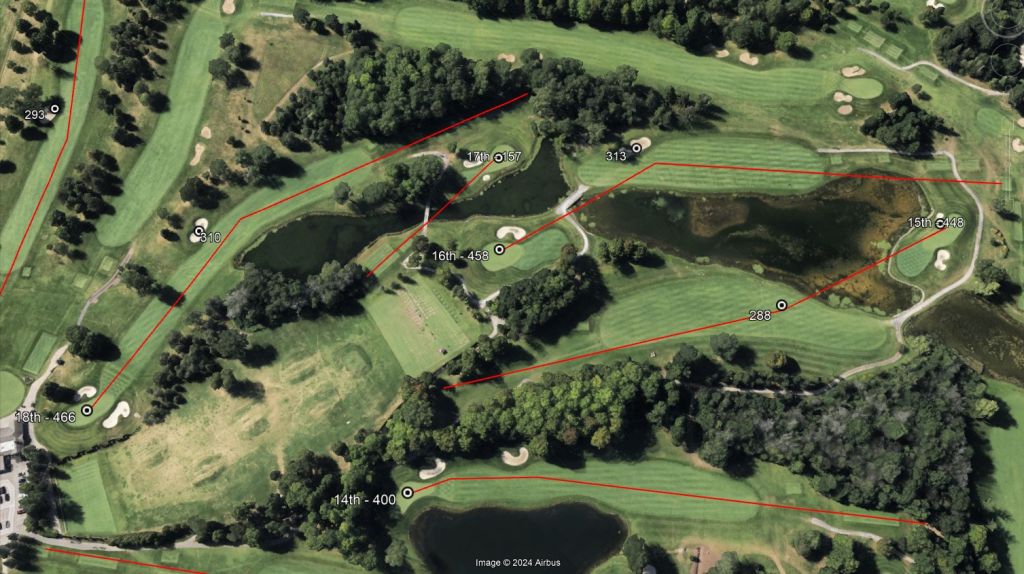
Once again, these holes are fairly redundant On the Par 4 14th, 15th, 16th and 18th, golfers absolutely cannot miss left because they will hit it right into the water. Find the short grass off the tee, and it then becomes a contest of who can hit a great shot between 150-175 yards for a good look at birdie to turn a match in their favor. And as for the short Par 3 17th, it once again asks a player to hit a precise shot from between 150-175 yards.
Despite the redundancy, though, there could be some late match drama. Matches can flip in a hurry if one pairing starts to play sloppy, or another pairing starts to heat up with their mid irons. And that’s the beauty of match play. The golf course really isn’t the star. It’s the drama created within the match as momentum shifts over and over. And because the final stretch of holes at Royal Montreal can create a ton of variance and volatility, there should be plenty of entertainment and drama to be had.
Even if the golf course is pretty mediocre.
The Teams
Longtime readers of this column are used to transition from a description of the golf course to an in depth look at what types of skillsets it should favor. And while we could speculate, by area, what types of players or skills will be needed to do well at Royal Montreal, we’re handicapping a Match Play event. There’s variables to consider outside of breaking down a golf course that feature too many unknowns to spend a significant amount of time on.
For example, the strategy of a four ball and alternate shot are vastly different. Four ball formats favor volatility and risk reward. Golfers might take chances they otherwise wouldn’t in a traditional stroke play event because they have a partner that can bail them out. A golfer might play two out of every three holes like an absolute donkey. But they could dominate their match if every three holes they make a crucial birdie to turn a match on its head.
Conversely, alternate shot is all about consistency. In a nutshell – just don’t get your partner in trouble. There’s no hiding in alternate shot. A player who is on top of their game could get absolutely sabotaged by their partner if they’re just off their game that day. Boring golf is key to alternate shots. Fairways. Greens. And sink the occasional long putt to flip matches. Limit the mistakes and you’ll probably win the match.
In addition, I just don’t see many things about Royal Montreal that would throw a monkey wrench into the event or heavily favor one particular skillset or another. It’s a very vanilla parklands golf course that is similar to lots of other golf courses played on the PGA Tour. Nothing any of these players will see this week will surprise them. And while the narrow fairways and thick rough will want to promote finding fairways, there’s opportunities for longer hitters to try and cut corners and bunkers to take trouble out of play. There’s a little bit of something for everyone at Royal Montreal, despite its narrow parklands set up.
So instead of trying to pick apart Royal Montreal, let’s instead pick apart the teams as a whole.
Let’s first start with the heavily favored United States Team, who on most books sits as a -250 favorite to win the 2024 Presidents Cup:
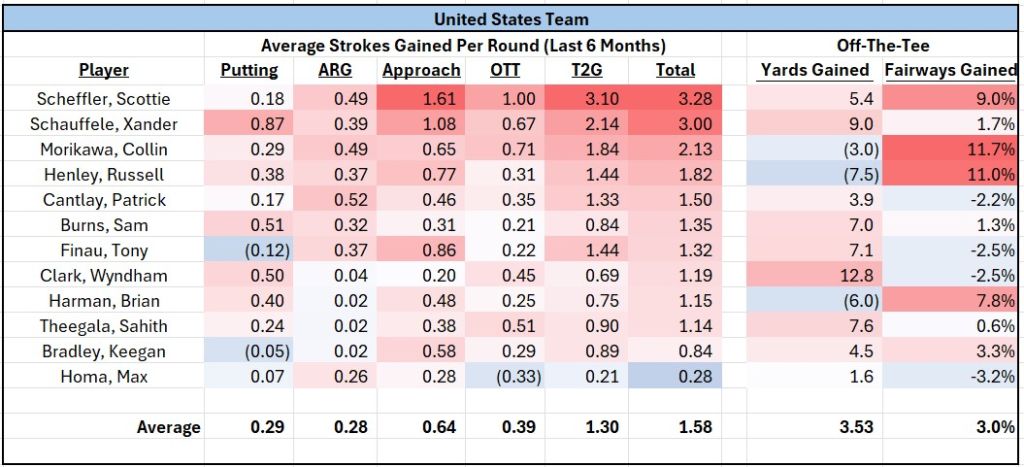
As always, the United States features a very strong team on paper top to bottom. There’s not a lot of weak spots on this team, save for a couple problem areas for a few players.
One of the stereotypes of most United States team for the last decade or so is they’re a bunch of bomb and gougers. That’s definitely not the case with this team. Not only is it well-balanced, it’s not a team that overly relies on length at the expense of accuracy. To the contrary, while there’s still plenty of length on this team there’s a lot of players who also find the fairway at an above average rate. Overall, this team is built more on total driving than just hitting it as far as they can.
If there is a knock on this team overall, it’s more qualitative than quantitative. Sure, players like Scottie Scheffler, Xander Schauffele, Patrick Cantlay and Collin Morikawa are elite players, even if they’re not in the best of form, who carry enough gravitas to elicit natural intimidation to their opponents. Its this intimidation that gives them the edge in Strokes Gained – Mentality, which is just as important in match play than statistical edges itself.
But as for the rest of the team, who on the United States strikes fear in the hearts of the Internationals? Are any of them shaking in their boots if they’re paired up against Russell Henley? Or Tony Finau? Or Wyndham Clark? While they’re very talented players, they’re not going up against true professional golf legends and alphas like Justin Thomas, or Jordan Spieth, or Brooks Koepka, or Dustin Johnson, or other golfers with massive auras.
So while yes, the United States is stacked from a statistical perspective, most of this team are players the Internationals look at and think “yeah, I can beat this guy”.
Next, let’s take a look at the Internationals, who once again are heavy underdogs on their home turf:
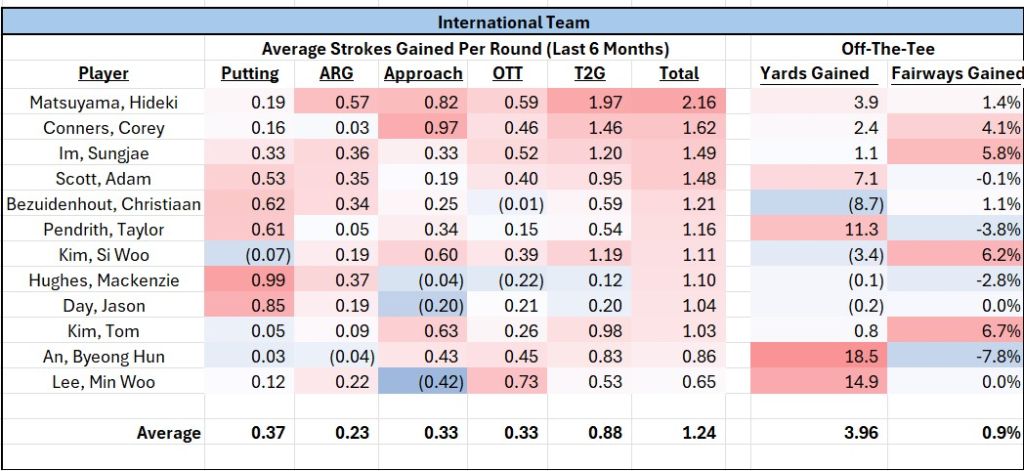
Make no mistake about it – the Internationals deserve to be underdogs. Overall, it’s not a particularly strong squad, not only in talent but also because players who would make this team stronger are ineligible to play because they’re in the LIV Golf league. This team definitely could use a Cameron Smith. Or a Joaquin Niemann. Or even a revitalized Louis Oosthuizen.
Unfortunately, they’ll have to make due with what they have. And they do have some bright spots. They have more than a few players who have been pretty efficient tee-to-green over the last six months. They have a diverse collection of skills off the tee in that they have plenty of bombers and plenty of accurate players. That will help Mike Weir make smart pairings to match players strengths and weaknesses throughout the competition.
In addition, many players on the Internationals come in playing some pretty good golf. Hideki Matsuyama won the FedEx St. Jude in August. Adam Scott has four Top 10’s in his last 5 starts, including a pair of runner up finishes. Corey Conners has five Top 10’s in his last 10 starts. Mackenzie Hughes enters the Presidents Cup off the heels of a 4th place finish at the Procore Championship. And both Sungjae Im and Taylor Pendrith have played solid golf over the last couple of months.
The Internationals shouldn’t have much course rust either. Adam Scott, Si Woo Kim and Byeong Hun An all are currently playing the BMW PGA Championship at Wentworth this week. And Corey Conners, Mackenzie Hughes, and Min Woo Lee played the Procore Championship two weeks ago. Conversely, only three of the 12 Americans have played competitive golf since the Tour Championship. Like the 2023 Ryder Cup, the Internationals enter the competition with more course reps under their belt than the Americans.
Lastly, where the Internationals are better on the stats page is in putting. Five of the top six putters over the last six months are on the International team. In Match Play, a hot putter can single handedly win a match. If several members of the Internationals catch fire on the greens, they’ll be tough to beat no matter how much better ball-strikers the Americans are.
Will that edge be enough for the Internationals to capture only their second outright victory at the Presidents Cup in 2024? Time will tell.
https://www.youtube.com/watch?v=videoseries
Approach Shots
If there is a particular skillset to focus on as a potential advantage between the teams, it’s in the approach shots. In match play, the ability to give your team our yourself a high volume of great looks for birdie, or the ability to limit critical mistakes, is key to winning your match. As such, let’s take a look at what type of approach shots players will hit most often at Royal Montreal, and who excels the most in that particular area.
Based on a review of the golf course, here is an estimate of the types of approach shots players will hit at the 2024 Presidents Cup:
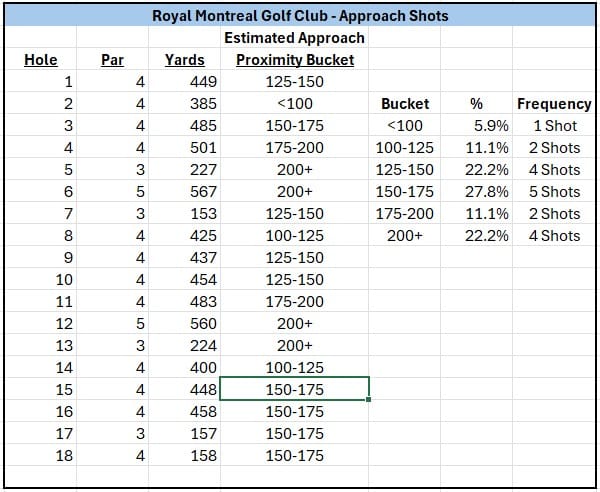
About half of the approach shots will come from between 125-175 yards. And seven shots total will come from under 150 yards, seven will come from between 150-200 yards, and only 4 shots will come from over 200 yards. The low volume of long approach shots is due to the relatively short length of the Par 4’s, the presence of only two Par 5’s, and only two of the four Par 3’s stretched to over 200 yards in length.
As such, here’s is a summary of how well each team has fared from less than 150 yards, from between 150-200 yards, and over 200 yards in 2024:
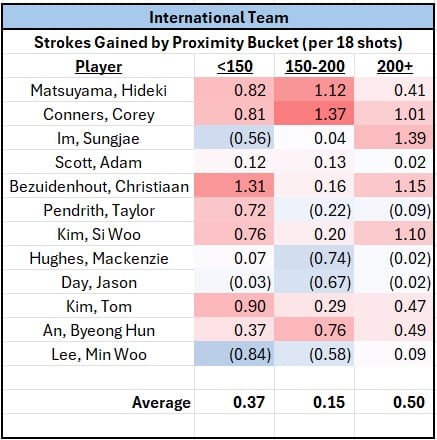
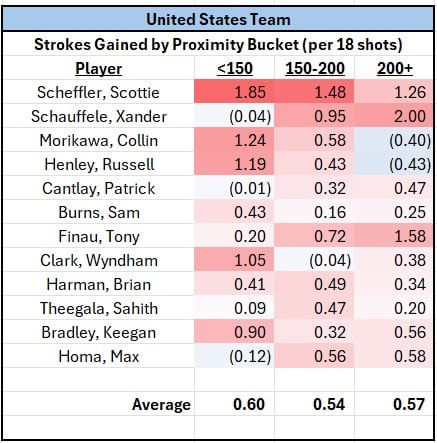
Unfortunately for the home team, not only do the Americans boast the better iron players top to bottom, but they’re decisively better in the proximity buckets with the highest volume of shots at Royal Montreal. In 2024, the Americans, on average, were about a quarter stroke per round better from less than 150 yards than the Internationals. And between 150-200 yards, which are the key distances players must hit approach shots from in the closing five holes, the Americans were about 0.4 shots per round better than the Internationals.
The deficiency between 150-200 yards for the Internationals is the most alarming. Mackenzie Hughes, Taylor Pendrith, Jason Day and Min Woo Lee are flat out horrible from that range. And Sungjae Im, Adam Scott and Si Woo Kim were only slightly above average from that range. If the Internationals are going to pull an upset, this area needs to be better for the squad. Otherwise, it’ll be another L for the World Golfers.
Official Pick
Look, the United States is probably going to win again. The question is by how much.
When the Americans have been the home team, they’ve dominated the Presidents Cup. But the last two times they’ve been the road team, they struggled to keep their grasp on the Presidents Cup. Even with the vast talent advantages on paper that they always seem to enjoy.
Consider the last two times they’ve played in hostile territory in the Presidents Cup:
2015:
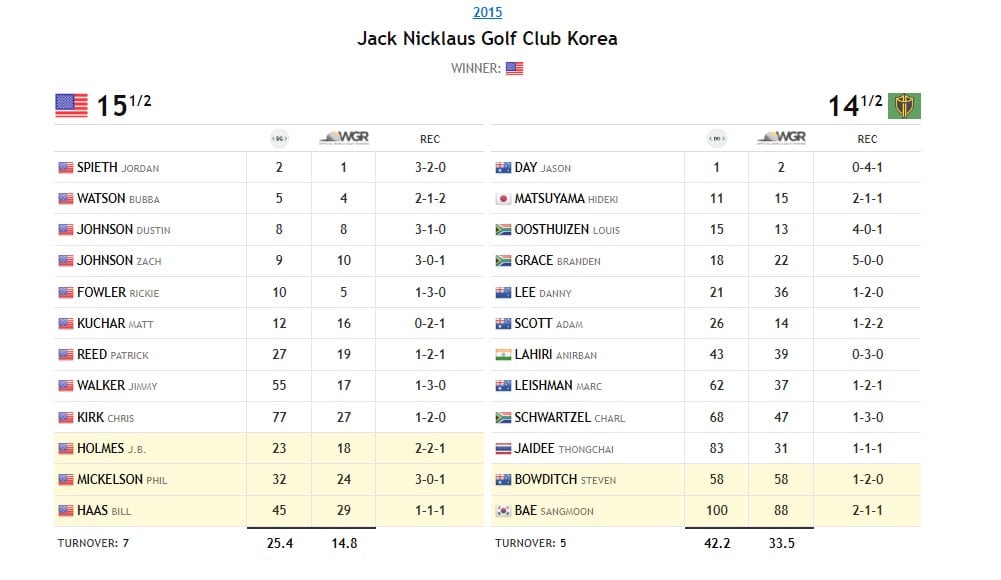
The Internationals had a very top heavy team of elite talents. But the bottom half of its roster was pretty poor. They couldn’t hide all of Thongchai Jaidee, Anirban Lahiri, Steven Bowditch and Sangmoon Bae during the competition. And these players simply weren’t in the same class at the Americans.
And yet, this one was a nailbiter. Heading into Sunday Singles, the United States held a slim 9.5-8.5 lead over the Internationals. And while the Americans guaranteed to retain the Presidents Cup when Bill Haas went one up on Sangmoon Bae in the final match of the session, the Internationals could get the unofficial win by tying the Americans. That would have been utterly embarrassing for the Americans and a huge moral victory for the Internationals.
Instead, Sangmoon Bae succumbed to the immense pressure of performing in front of his home country. He chunked his chip shot to hand the Americans the outright victory. And to make matters worse, immediately after the competition he was handed a K2 assault rifle and whisked away to the 38th parallel.
While the Americans won outright, this one was way closer than it should have been.
2019:
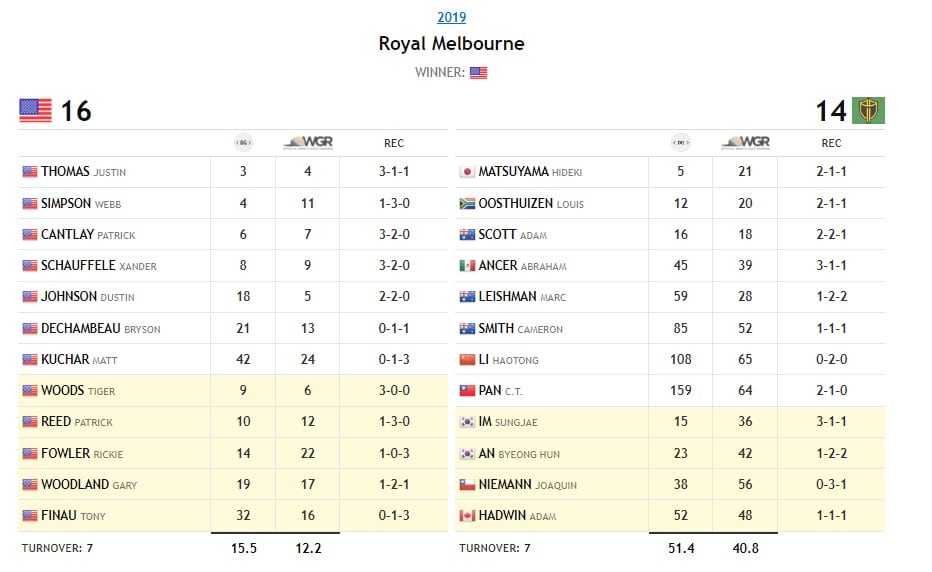
Once again, the Americans enjoyed a massive advantage in talent on paper. The 2019 team fielded by the Internationals was one of the weaker ones they’ve ever put out. Once again, the back end of their team was with golfers who were massively outclassed by their peers. In addition, future stars Cameron Smith and Joaquin Niemann weren’t nearly the players then that they are now. And it lacked experience. Only Matsuyama, Oosthuizen, Adam Scott, and Leishman had previous Presidents Cup experience.
But a combination of masterful captainship by Ernie Els, who had the Internationals prepared to attack Royal Melbourne with both analytically based pairings and an elite scouting report of the golf course, and a woeful display from Captain Tiger Woods, who did not adequately prepare the United States for Royal Melbourne and put out some truly awful pairings (including incredulously pairing Patrick Reed and Webb Simpson together for three straight losses) saw the United States embarrassingly down two points heading into Sunday Singles.
But during the competition, Player Tiger Woods bailed out Capitan Tiger Woods by asserting his dominance as the alpha player in the competition. Xander Schauffele and Patrick Cantlay emerged as the next power team for the United States. And the massive talent advantage enjoyed by the Americans simply was too much for the underdog Internationals to overcome once the format switched to singles. On Sunday, the Americans earned 8 of the possible 12 points in Sunday singles to end the Internationals upset bid and win the Presidents Cup outright once again.
But once again, the United States woefully underperformed in hostile territory despite massive talent advantages. Blame certainly can be laid upon Captains Jay Haas and Tiger Woods. But parlaying these struggles with the Americans struggles on foreign soil in the Ryder Cup, are the Americans simply a bunch of front runners who when the going gets tough in front of a hostile crowd, they shrink in the spotlight?
And if so, why should we expect anything different in front of what’s sure to be a raucous Canadian crowd quick to lob insults after hours of downing Molsons and Labatts under the hot sun. Shouldn’t the best bet be to hammer the Internationals with the spread?
But this time around, I don’t foresee similar struggles for the Americans like they had in 2015 and 2019. For starters, it’s possible the extreme time zone adjustment needed for the Americans to play in Korea and Australia rattled the team. That won’t happen this year, as the 2024 Presidents Cup will be played in a very comfy Eastern Time Zone. That has to negate any potential advantages at home for the Internationals.
In addition, while a venue like Royal Melbourne has a ton of character and nuance that requires a detailed scouting report to ready a team, Royal Montreal features a very basic set up that isn’t much different than other venues seen on the PGA Tour. There’s just not a ton the golf course will throw at the Americans that is unfamiliar to them. They play plenty of narrow parkland golf courses on the PGA Tour. It’s on a bentgrass/poa green, which is a surface featured at several PGA Tour venues. And most importantly, it’s a Rees Jones design. If you played one Rees Jones, you’ve likely played them all.
Royal Montreal is about as friendly and comfortable to the typical elite American PGA Tour golfer as there is. And as long as they can block out the noise from the hometown crowds, the United States should comfortably win the competition and retain the Presidents Cup by a comfortable margin. Either lay the juice at -250 or bet them against the spread. It’ll be another party for the USA come Sunday afternoon.





